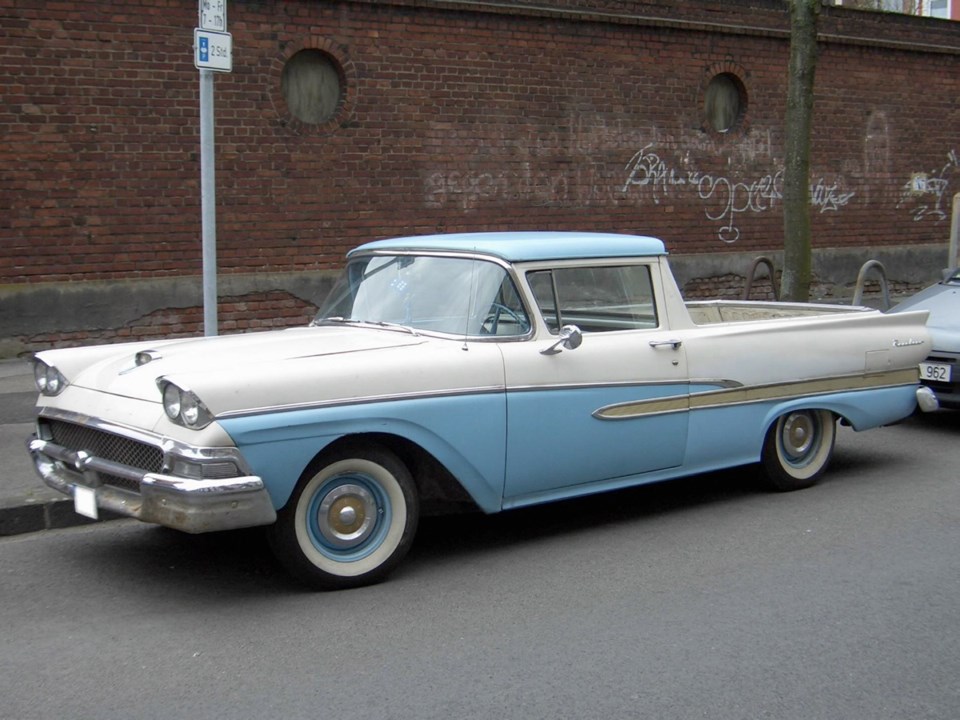Before pickup trucks gradually evolved into their own more rugged form in the late 1930s and ’40s, most were based on cars. Examples of pre-war sedan-based pickups were produced by Ford, Chevrolet and Dodge. Some, such as Ford, Chevrolet, Hudson and Studebaker, also marketed what they called coupe-pickups, a coupe car with a drawer-like cargo box that slid out of the trunk.
Studebaker’s Coupe Express wasn’t revived after the war, but Hudson did bring back its handsome car-based pickup, which it built until 1947. It became uneconomic in 1948 when Hudson converted to unit-construction cars.
As pickup trucks became more heavy-duty and utilitarian, the North American sedan-pickup languished for a decade, except briefly for tiny Crosley, whose pickup was too small to be practical. In 1957, Ford resurrected the sedan pickup with its modern and stylish Ranchero, a smart-looking car-truck based on a Ford station-wagon chassis. It was more car-like than the Hudson and Studebaker had been, and the integrated cab and cargo box became a defining sedan-pickup characteristic.
Apart from its practical side as a conveyance for businessmen and merchants, Ford hoped it would subliminally appeal to the suburban man who imagined himself a rugged ranch owner, or perhaps a gentleman farmer.
For women, Ford was hoping to awaken a dormant desire to escape suburbia for the freedom and open spaces of the country life, where she would be the matron of the spread.
Although Ford’s Ranchero beat rival Chevrolet’s El Camino to market by two years, General Motors had really taken a step toward the luxury pickup a couple of years earlier with the 1955 Chevrolet Cameo Carrier (and twin GMC version). They were, however, still based on a regular pickup.
The Cameo Carrier was trimmed with more chrome and a special red-and-white paint treatment. The cargo box appeared as wide as the cab with bolt-on sculpted plastic sides that carried through to the rear, where it finished off with car-like taillights and concealed tailgate hinges.
Although made for only three years and not sold in large numbers, the Cameo laid the groundwork for fashionable pickups. But it was still truck-based, and that’s where the Ranchero broke new ground.
The Ranchero was built on the 2,946-millimetre Ford Custom sedan/station wagon wheelbase. And since its introduction coincided with completely restyled longer-lower-wider 1957 Fords, it had a completely fresh appearance.
Being derived from the two-door wagon, the Ranchero’s tailgate was formed from the lower part of the wagon’s rear door. And since Ford already offered a wagon-based light commercial sedan-delivery model, transition to the Ranchero was relatively easy.
Under the front-hinged hood, the base engine was the corporate overhead-valve, 3.6-litre (223 cu in.) 144-horsepower inline six. Optional was a 4.5-litre (272 cu in.) overhead-valve V-8. A few came with 5.1 (312) V-8s, some with four-barrel carburetors and even supercharging. Standard transmission was a three-speed manual with optional overdrive, or “Fordomatic.”
Being based on a passenger vehicle allowed Ranchero buyers to equip it with such then-untrucklike luxuries as air conditioning and power brakes, steering, seats and windows. It also had a wraparound windshield, a popular styling feature of the day.
Ford offered the Ranchero in several two-tone colour combinations. From the tops of the windows to the mid-point of the body was Colonial White. Buyers could specify such companion colours as Doeskin Tan, Flame Red or Inca Gold for the roof and lower body, and extra flash could be had in the form of gold anodized side-spear trim.
The Ranchero’s advertising theme concentrated on its dual-purpose capabilities. “After the day’s work is done, Ranchero’s ready for the evening fun,” went the copy. Or “a handsome caller … a husky hauler.” And indeed, with its six-foot (1,829 mm) bed and carrying capacity of 540 kilograms, the Ranchero was quite a utilitarian vehicle. It soon became de rigueur for gentlemen farmers.
It even had exposure on the silver screen in April Love, a 1957 movie in which Pat Boone wooed the lovely Shirley Jones (in song, of course, this was the 1950s) in a Ford Ranchero. The stylish Ranchero was a real scene-stealer.
In spite of being introduced in November 1956, which gave it a shortened model year, Ford sold a respectable 21,706 1957 Rancheros. They also produced a Meteor version in Canada.
After only three years on the full-size chassis, the 1960 Ranchero was switched to the new compact Falcon platform. It would later be based on the Fairlane-Torino, and finally the Gran Torino-LTD II before its demise in 1979.
Although Chevrolet’s El Camino competitor arrived in 1959, Ford had shown the way in 1957 and proved it was possible to build a truck that was as luxurious as a passenger car.



